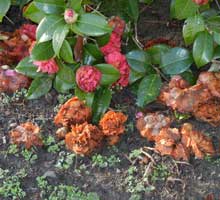 Did we just have a couple of little cold snaps? I mean, did anybody besides me notice things got a little chilly out there in the garden? I’m sure everyone’s treasured garden plants and protected container plants came through just fine – right?
Did we just have a couple of little cold snaps? I mean, did anybody besides me notice things got a little chilly out there in the garden? I’m sure everyone’s treasured garden plants and protected container plants came through just fine – right?
The waterfront garden in Beaufort County actually has come through it all relatively unscathed; I’ve long since abandoned trying to be too sly about terribly tender plants in that garden, and the moderating influence of the tidal creek makes some things that would be quite marginally hardy persistent through most conditions.
The glorious Magnolia x loebneri “Leonard Messel” has started its gorgeous show of pink five-inch blooms, each with a dozen or so strap-like petals. It’s earlier this year than the old-fashioned Magnolia soulangeana, which sits exposed just back from the edge of the bluff, twenty feet tall, and which almost always shows frost damage if the weather drops below thirty-two when the blooms are open.
The huge Crinum asiaticum, the Giant Spider Lily, kept its long green leaves well into December this year. Usually an early frost knocks it back to the ground, mushifying it into an ugly low mound of brown. This kill-back actually does wonders protecting the big bulb growing just at ground level; it keeps the heart of the plant alive to send up that magnificent foliage in the spring – and the breathtaking spidery blooms atop tall thick stems in the summer. These blooms seem to attract late-evening visitors – also huge – to pollinate and sip sweet nectar. Great sphinx moths will sometimes congregate among these flowers, an amazing sight; the first time I saw this, I didn’t know what it was. Could that be some mutant nocturnal hummingbird? Google “sphinx moth” or “hawk moth” and you’ll find remarkable images of the moths going to the rare Ghost Orchid.
There’s no cold damage at all to my Cycads, those surprisingly tough Sago palms in many Beaufort gardens. These are protected from the cold blasts by an overstory of high pine trees and dense woods on the west. There have been cold winters which have left their dark green fronds burned, but even then they manage usually to send out a flush of new growth to replace all those brown fronds. This year the new growth will add to the undamaged corona of big palm-like foliage that made it through the winter.
Likewise, the Hydrangeas seem to have weathered the winter freeze with little damage. Even if the more delicate ones die back, they’ll usually put up new growth from the ground. I’ve come to expect some killing back on the taller H. macrophylla types, the mop-head and lace-cap garden hydrangeas. That gives me a good excuse to prune back those dead branches before spring growth starts . . . I’ve written about that pruning before, so I’ll not bother to repeat those ideas; just look back in the archived articles in Lowcountry Weekly’s How Does Your Garden Grow series.
Having said all that about our good fortune in the Northern Beaufort County garden, I find I am at a loss for words for how the inland garden has fared. The cold was much more intense in the upper-Lowcountry/lower-midlands section of the state during that “polar vortex” storm that came through several weeks back. Then the ice storm of February 12 came, and we were in the path of its worst intensity.
Plants in this garden have severe damage, even many very hardy ones. I can’t tell yet whether the many varieties of Crinum lily have survived – they look truly awful. The same for the Agapanthus bulbs. Even the Daphne odora, which was ready to open its superbly fragrant flowers, is burnt badly by the repeated insults of this winter.
Despite appearances during the worst of the storm, my magnificent and much-loved camellias – both C. sasanqua and C. japonica – survived well and undamaged. The quite old sasanquas, reaching fifteen to twenty feet high, had been bent down to a horrifying mound about three feet off the ground. Those branches are astonishingly resilient – they returned to full height as soon as the ice melted, with almost no loss of a twig.
The lovely blue Cupressus arizonica “Carolina Sapphire” cypress was similarly bent flat to the ground. It, too, sprang back to full verticality, and that beloved gift from my Bookie friend Chris Stanley will continue to grow magnificently.
A number of my tender plants were placed in my little greenhouse for winter protection, along with a few new, not-yet-established tougher plants. Unfortunately, both the “vortex” storm and the ice storm took a disappointing toll on these. Almost all the tender plants were lost – Bird’s Nest Ferns, Thanksgiving Cactus, Bromeliads, Begonias, Orchid Cactus, Nun’s Orchid, and more. We lost power the afternoon of the storm, and it was off for a week. No heat in the green house, and none in the house. (For us in the house, including my 90-year-old mother, there was no water either. That tough old bird handled things a hell of a lot better than these exotic plants did!)
My true heartbreak, though, was the tremendous damage to the old trees. We had thousands of limbs down. Trees were topped out; some were tipped over by the massive weight of the ice on the limbs, ice nearly an inch thick. Our magnificent live oaks and southern magnolias, trees which keep their wonderful foliage all year, offered much more surface area for ice to build up. The additional weight made for even greater destruction to these trees, with great trees splitting in two and giant limbs crashing to the ground. The silence of the ice accumulation made a distressing backdrop to the impossibly loud “BANG!”, “POP!”, gunshot sounds through the night and the following day – the sound of trees snapping off and tumbling to the icy forest floor or the white lawn.
The famous humanitarian and philosopher, R. Bruce Marshall, pointed out that this is awfully like the damage wreaked by Hurricane Hugo, and that the emotional cost of this kind of loss is massive.
It is certainly worth remembering that Nature has a remarkable capacity for recovery – the pain of the loss of such glory does eventually pass. That process is helped along by close observation of rebounding growth, new seedlings finding light and nutrients, broken limbs bursting with new leaves. For gardeners, this is what we face in miniature every season. We gardeners quickly remember the cycle of life – and when we forget its inexorability, the garden very quickly slaps us into recognition. With a garden, its plantings and its soil, we are eventually brought to our knees. Seems just about right.







